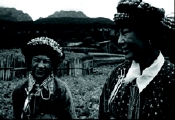Sex at Dawn: The Prehistoric Origins of Modern Sexuality (20 page)
Read Sex at Dawn: The Prehistoric Origins of Modern Sexuality Online
Authors: Christopher Ryan,Cacilda Jethá
Tags: #Non-Fiction, #Sociology, #Psychology, #Science, #Social Science; Science; Psychology & Psychiatry, #History


Mosuo woman (Photo: Jim Goodman)
Mosuo
women
(Photo:
Sachi
Cunningham/
www.germancamera.com)
On the Inevitability of Patriarchy
Despite societies like the Mosuo’s in which women are autonomous and play crucial roles in maintaining social and economic stability, and plentiful evidence from dozens of foraging societies in which females enjoy high status and respect, many scientists rigidly insist that all societies are and always have been patriarchal. In
Why Men Rule
(originally titled
The Inevitability of Patriarchy),
sociologist Steven Goldberg provides an example of this absolutist view, writing, “Patriarchy is universal…. Indeed, of all social institutions there is probably none whose universality is so totally agreed upon…. There is not, nor has there ever been, any society that even remotely failed to associate authority and leadership in suprafamilial areas with the male. There are no borderline cases.”13 Strong words. Yet, in 247 pages, Goldberg fails to mention the Mosuo even once.
Goldberg does mention the Minangkabau of West Sumatra, Indonesia, but only in an appendix, where he cites two passages from others’ research. The first, dating to 1934, says that men are generally served food before women. From this, Goldberg concludes that males wield superior power in Minangkabau society. This is as logically consistent as concluding that Western societies must be matriarchal because men often hold doors open for women, allowing them to pass first. The second passage Goldberg cites is from a paper co-authored by anthropologist Peggy Reeves Sanday, suggesting that the Minangkabau men have some degree of authority in the application of various aspects of traditional law.

Minangkabau woman and girls (Photo: Christopher Ryan)14
There are two big problems with Goldberg’s application of Sanday’s work. First, there is no inherent contradiction between claiming that a society is
not
patriarchal and yet that men
do
enjoy various types of authority. This is simply illogical: Van Gogh’s famous painting
The Starry Night
is not a “yellow painting,” though there is plenty of yellow in it.
The second problem with this citation is that Peggy Reeves Sanday, the anthropologist Goldberg cites,
has consistently
argued that the Minangkabau are matriarchal.
In fact, her most recent book about the Minangkabau is called
Women at
the Center: Life in a Modern Matriarchy.15
Having spent over twenty summers living among the Minangkabau, Sanday says, “The power of Minangkabau women extends to the economic and social realms,” noting, for example, that women control land inheritance and that a husband typically moves into the wife’s household. The four million Minangkabau living in West Sumatra consider themselves to be a matriarchal society. “While we in the West glorify male dominance and competition,” Sanday says, “the Minangkabau glorify their mythical Queen Mother and cooperation.” She reports that “males and females relate more like partners for the common good than like competitors ruled by egocentric self-interest,” and that as with bonobo social groups, women’s prestige increases with age and “accrues to those who promote good relations….”16
As happens so often in trying to understand and discuss other cultures, wording trips up specialists. When they claim never to have found a “true matriarchy,” these anthropologists are envisioning a mirror image of patriarchy, a vision that ignores the differing ways males and females conceptualize and wield power. Sanday says that among the Minangkabau, for example, “Neither male nor female rule is possible because of
[their] belief that decision-making should be by consensus.” When she kept asking people which sex ruled, she was finally told that she was asking the wrong question. “Neither sex rules … because males and females complement one another.”17
Remember this when some loudmouth at the bar declares that
“patriarchy is universal, and always has been!” It’s not, and it hasn’t. But rather than feel threatened, we’d recommend that our male readers ponder this: Societies in which women have lots of autonomy and authority tend to be decidedly male-friendly, relaxed, tolerant, and plenty sexy. Got that, fellas? If you’re unhappy at the amount of sexual opportunity in your life, don’t blame the women. Instead, make sure they have equal access to power, wealth, and status. Then watch what happens.
As with bonobos, where female coalitions are the ultimate social authority and individual females need not fear the larger males, human societies in which women are “sassy and confident,” as Barnes described the Mosuo girls—free to express their minds and sexuality without fear of shame or persecution—tend to be far more comfortable places for most men than societies ruled by a male elite. Maybe matriarchal societies are so difficult for Western male anthropologists to recognize because they expect a culture where men are suffering under the high heels of women—a reverse reflection of the long-standing male oppression of women in Western cultures. Instead, observing a society where most of the men are lounging about relaxed and happy, they conclude they’ve found yet another patriarchy, thereby missing the point entirely.
The March of the Monogamous
The idea of monogamy hasn’t so much been tried and found
wanting, as found difficult and left untried.
G.
K. CHESTERTON
The surprise box-office hit of 2005 was a film called
March
of the Penguins.
The second-biggest money-making documentary to date, viewers were touched by its depiction of the extreme dedication penguin couples showed in nurturing their adorable penguin pups. Many viewers saw their own marriages reflected in the penguins’ sacrifice for their offspring and for each other. As one reviewer put it, “It’s impossible to watch the thousands of penguins huddled together against the icy Antarctic blasts … without feeling a tug of anthropomorphic kinship.” Churches across the United States reserved cinemas for private screenings for their congregations. Rich Lowry, editor of
The NationalReview
, told a conference of young Republicans, “Penguins are the really ideal example of monogamy. The dedication of these birds is amazing.” Adam Leipzig, president of
National
Geographic Feature Films,
declared the penguins “model parents,” continuing, “What they go through to look after their children is phenomenal, and no parent who sees it will ever complain about the school run. There are parallels with human nature and it’s moving to see.”18
But unlike the birds themselves, penguin sexuality is not all black and white. That perfect penguin pair, that “ideal example of monogamy,” those “model parents” are monogamous only as long as it takes to get their little one out of the egg, off the ice, and into the frigid Antarctic water—a little less than a year. If you’ve seen the film, you know that with all the trekking back and forth across the windswept ice and huddling against raging Antarctic blizzards, there’s not much in the way of extramarital temptation anyway. Once Junior is swimming with the other eleven-month-olds—the penguin equivalent of kindergarten—fidelity is quickly forgotten, divorce is quick, automatic, and painless, and Mom and Dad are back on the penguin prowl. With a breeding adult typically living thirty years or more, these “model parents” have at least two dozen “families” in a lifetime. Did someone say “ideal example of monogamy”?
Whether you found the film to be cloyingly sweet or refreshingly so, a bold, if somewhat perverse, double feature would pair
The March of the Penguins
with Werner Herzog’s
Encounters at the End of the World.
Herzog’s documentary of the Antarctic is a masterpiece of photography and interviews with a range of surprising characters, including Dr. David Ainley, an almost comically reserved marine ecologist who has been studying penguins in Antarctica for two decades.
Under Herzog’s wry questioning, Ainley reports having witnessed cases of penguin ménages-à-trois, in which two males take turns caring for a particular female’s egg, as well as “penguin prostitution,” where females receive prime nest-building pebbles in exchange for a bit of penguin poontang.
The prairie vole is another supposed paragon of “natural monogamy.”According to one newspaper article, “Prairie voles—squat
rodents
indigenous
to
plains
and
grasslands—are considered to be a near-perfect monogamous species. They form pair bonds that share a nest. Both male and female actively protect each other, their territory, and their young. The male is an active parent and, if one of the pair dies, the survivor does not take a new mate.”19
Considering the vitriol Darwin faced 150 years ago when he dared compare humans to apes, it’s striking to note the scraps of comfort contemporary scientists find in equating human sexual behavior with that of the ratlike prairie vole. We who once compared ourselves to angels now see ourselves reflected in this lowly rodent. But C. Sue Carter and Lowell L. Getz, who have studied the biology of monogamy in prairie voles and other species for thirty-five years, are unambiguous: “Sexual exclusivity,” they write “is not a feature of [the vole’s] monogamy.”20 Thomas Insel, director of the National Institute of Mental Health (formerly director of Yerkes Primate Center) and an expert on the prairie vole, says that those in the know have a less exalted view of the prairie vole’s monogamy: “They’ll sleep with anyone but they’ll only sit by their partners.”21
Then there’s that line (invariably directed at women, for some reason) that goes, “If you’re looking for monogamy, marry a swan.”*
So what about swans, then? Many species of birds have long been believed to be monogamous because two parents are needed for the 24/7 labor of incubating eggs and feeding nestlings. As with humans, investment-minded theorists assumed males would help out only if they were certain the young were their own. But the recent advent of affordable DNA testing has blown embarrassing holes in this story, too.
Although a pair of bluebirds may build a nest and rear the young together, an average of 15 to 20 percent of the chicks are not sired by the male in the partnership, according to

Patricia Adair Gowaty, a behavioral ecologist. And bluebirds aren’t particularly slutty songbirds: DNA studies of the chicks of some 180 bird species previously thought to be monogamous have shown that about 90 percent of them aren’t. Swans, alas, are not among the virtuous 10 percent. So if you’re looking for monogamy, forget the swan, too!
Is monogamy natural? Yes…. Human beings almost never
have to be cajoled into pairing. Instead, we do this naturally.
We flirt. We feel infatuation. We fall in love. We marry. And
the vast majority of us marry only one person at a time.
Pair-bonding is a trademark of the human animal.
HELEN FISHER
Strange trademark for a species that enjoys so much extra-pair sexual activity. The glue holding the standard narrative together is the assumption that
to marry
and
to mate
have universally applicable meanings, like the verbs
to eat,
or
to give birth.
But whatever terminology we use for the socially approved special relationship that often exists between men and women around the world will never communicate the universe of variations our species comes up with.